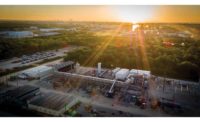Two recent projects to capture and store carbon emissions from large coal-fired powerplants have had very different outcomes: One was completed this spring and is undergoing testing and commissioning; the other is months behind schedule and way over budget.
The Boundary Dam project in Saskatchewan went up relatively smoothly, although there were challenges during the construction phase, says SaskPower President and CEO Robert Watson. But the Kemper County carbon capture and storage (CCS) project in Mississippi has been plagued with problems and setbacks; most recently, this spring, Southern Co., the owner, announced the plant would likely not be operational until the first quarter of 2015.
Still, Dept. of Energy officials and the Obama administration have high hopes for the Kemper facility, which they believe will show CCS can be achieved at a utility-scale powerplant in the U.S. DOE Secretary Ernest Moniz visited the Kemper facility in November 2013 and praised Southern Co. for "leading us all toward a 21st-century energy portfolio."
CCS is important because it is a key component of the Obama administration's efforts to mitigate the effects of climate change. According to the U.S. Environmental Protection Agency, powerplant emissions account for more than 40% of U.S. CO2 emissions each year.
In fall 2013, EPA unveiled its proposed New Source Performance Standards (NSPS), which would require coal- and oil-fired plants to drastically reduce their emissions of CO2 and other greenhouse gases. The best tool, according to EPA, is CCS technology. But while EPA has made CCS the linchpin of its proposed standards for new powerplants, power and construction industry experts argue the technology has not been adequately demonstrated at a commercial scale.
Power executives acknowledge CCS is important, but they say the current regulations miss the mark and could create a disincentive to develop the technology further. As a result, conservative lawmakers are lining up with the power sector to oppose what they contend is the administration's environmental overreach, and many observers expect a legal challenge to the regulations once they become final sometime next year.
Michael Wara, an associate professor at Stanford University's law school who has worked with the Brookings Institution and with environmental groups on cap-and-trade and other issues, says the key question with the NSPS rule is: "Is CCS adequately demonstrated? It's going to be a hard-fought legal battle."
Carbon Capture Inescapable
The EPA proposal does not mandate CCS. But many industry experts say that in order for coal-fired plants to meet the target reductions of 1,100 lb of CO2 per megawatt-hour gross over a 12-month operating period, or a 1,000 lb to 1,050 lb CO2/MWh gross reduction over a seven-year period, partial (65%) capture is required. Separate targets were established for natural-gas plants. Further, on June 2, EPA released its proposed rule for reducing greenhouse emissions from existing powerplants. It does not require CCS as a solution, although utilities have the option to use it if it works for them.
In drafting the proposal for new powerplants, EPA relied on Section 111(b) of the Clean Air Act, which requires that EPA establish the best systems for emissions reductions that are technically feasible and adequately demonstrated. For the EPA, that means partial CCS. But numerous engineering firms and utilities argue the technology has not been adequately demonstrated at a commercial scale.
CCS has not yet been successfully deployed at a single utility-scale powerplant, says Melissa McHenry, an American Electric Power spokeswoman. "It has not actually been deployed at a working powerplant, except at a very small, 20-MW scale," she says.








Post a comment to this article
Report Abusive Comment